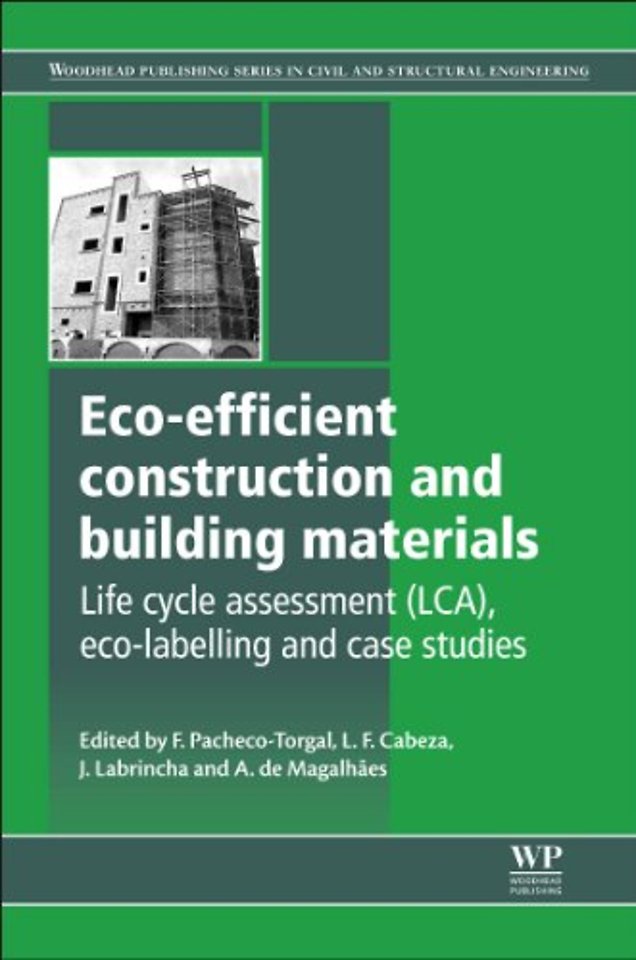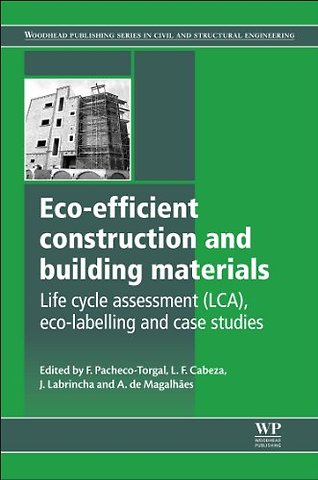<ul> <li>Contributor contact details</li> <li>Woodhead Publishing Series in Civil and Structural Engineering</li> <li>1: Introduction to the environmental impact of construction and building materials<ul><li>Abstract</li><li>1.1 Introduction</li><li>1.2 Environmental impact assessment</li><li>1.3 The European Construction Products Regulation (CPR)</li><li>1.4 Outline of the book</li></ul></li> <li>Part I: Life cycle assessment (LCA), eco-labelling and procurement<ul><li>2: Mineral resource depletion assessment<ul><li>Abstract</li><li>2.1 Introduction</li><li>2.2 Definition and classification of mineral resources</li><li>2.3 Trends in mineral use and depletion</li><li>2.4 Dynamic analysis of mineral resource use and depletion: the Hubbert peak model</li><li>2.5 From grave to cradle: A new approach to assess and account for mineral depletion</li><li>2.6 Conclusions</li></ul></li><li>3: Life cycle assessment (LCA) of sustainable building materials: an overview<ul><li>Abstract</li><li>3.1 Introduction</li><li>3.2 The environmental impact of building materials</li><li>3.3 Life cycle assessment (LCA) and sustainable building materials</li><li>3.4 Conclusions</li></ul></li><li>4: Life cycle assessment (LCA) of the building sector: strengths and weaknesses<ul><li>Abstract</li><li>4.1 Introduction</li><li>4.2 The overall strengths and limitations of life cycle assessment (LCA)</li><li>4.3 Strengths and weaknesses within LCA methodology</li><li>4.4 Conclusions</li></ul></li><li>5: Using life cycle assessment (LCA) methodology to develop eco-labels for construction and building materials<ul><li>Abstract</li><li>5.1 Introduction: life cycle thinking and eco-labels</li><li>5.2 Life cycle assessment (LCA)</li><li>5.3 Types of eco-labels and their relation to LCA</li><li>5.4 Environmental certification programmes for buildings</li><li>5.5 Future trends</li><li>5.6 Sources of further information and advice</li></ul></li><li>6: The EU Ecolabel scheme and its application to construction and building materials<ul><li>Abstract</li><li>6.1 Introduction</li><li>6.2 The EU Ecolabel and the European Commission policy for sustainability</li><li>6.3 History and goals of the EU Ecolabel scheme</li><li>6.4 EU Ecolabel establishment procedures and criteria</li><li>6.5 EU Ecolabel and green public procurement (GPP)</li><li>6.6 EU Ecolabel and national ecolabelling schemes</li><li>6.7 EU Ecolabel for eco-efficient construction and building materials</li><li>6.8 Future trends</li><li>6.9 Sources of further information and advice</li><li>6.11 Appendix: abbreviations</li></ul></li><li>7: Environmental product declaration (EPD) labelling of construction and building materials<ul><li>Abstract</li><li>7.1 Introduction</li><li>7.2 Regulatory framework</li><li>7.3 Objectives and general principles</li><li>7.4 Environmental product declaration (EPD) methodology</li><li>7.5 EPD programmes around the world</li><li>7.6 Product category rules (PCR) for construction and building materials</li><li>7.7 Case studies: EPD for construction and building materials</li><li>7.8 Conclusions</li></ul></li><li>8: Shortcomings of eco-labelling of construction and building materials<ul><li>Abstract</li><li>8.1 Introduction</li><li>8.2 Typical shortcomings of eco-labels</li><li>8.3 Building materials</li><li>8.4 Eco-labelling of buildings</li><li>8.5 Conclusions</li></ul></li><li>9: Green public procurement (GPP) of construction and building materials<ul><li>Abstract</li><li>9.1 Introduction</li><li>9.2 Green public procurement (GPP) and sustainable public procurement (SPP) as policy instruments</li><li>9.3 Policy context in the EU</li><li>9.4 Policy context in selected countries</li><li>9.5 The need for a paradigm shift</li><li>9.6 Implementing GPP/SPP in the construction sector</li><li>9.7 Key concerns for progress towards SPP</li></ul></li></ul></li> <li>Part II: Assessing the environmental impact of construction and building materials<ul><li>10: Assessing the environmental impact of conventional and ‘green’ cement production<ul><li>Abstract</li><li>10.1 Introduction</li><li>10.2 Environmental impact of ordinary Portland cement</li><li>10.3 Supplementary cementitious materials (SCMs)</li><li>10.4 Alternative binders</li><li>10.5 Balancing function and environmental impact</li><li>10.6 Conclusions and future trends</li></ul></li><li>11: Life cycle assessment (LCA) of concrete made using recycled concrete or natural aggregates<ul><li>Abstract</li><li>11.1 Introduction</li><li>11.2 Life cycle assessment (LCA) of recycled aggregate concrete (RAC)</li><li>11.3 Influence of different phases in the production process for natural and recycled concrete</li><li>11.4 Research on the use of natural and recycled aggregates in concrete</li><li>11.5 Analysis of the influence of the transport phase</li><li>11.6 Analysis of the influence of CO<sub>2</sub> uptake during the life cycle of concrete</li><li>11.7 Conclusions and future trends</li><li>11.8 Acknowledgement</li></ul></li><li>12: Life cycle assessment (LCA) of building thermal insulation materials<ul><li>Abstract</li><li>12.1 Introduction</li><li>12.2 Thermal insulation materials and their properties</li><li>12.3 Life cycle assessment (LCA) analysis of thermal insulation materials</li><li>12.4 The ecological benefits of thermal insulation of external walls of buildings</li><li>12.5 The economic benefits of thermal insulation</li><li>12.6 Conclusions</li></ul></li><li>13: Life cycle assessment (LCA) of phase change materials (PCMs) used in buildings<ul><li>Abstract</li><li>13.1 Introduction to phase change materials (PCMs) and their use in buildings</li><li>13.2 Investigating the use of PCMs in buildings</li><li>13.3 Life cycle assessment (LCA) methodology</li><li>13.4 PCM impact and selection</li><li>13.5 LCA of buildings including PCMs: case studies</li><li>13.6 Improvement in PCM use</li><li>13.7 Problems in undertaking an LCA of buildings including PCMs</li></ul></li><li>14: Life cycle assessment (LCA) of wood-based building materials<ul><li>Abstract</li><li>14.1 Introduction</li><li>14.2 Forestry and wood production</li><li>14.3 Wood product manufacture</li><li>14.4 Building with wood materials</li><li>14.5 Integrated energy and material flows</li><li>14.6 Wood products and climate change</li><li>14.7 Wood building materials: past and future</li><li>14.8 Sources of further information</li><li>14.9 Acknowledgement</li></ul></li><li>15: The environmental impact of adhesives<ul><li>Abstract</li><li>15.1 Introduction: growth in the usage of adhesives</li><li>15.2 Environmental implications of the growth in adhesive use</li><li>15.3 Adhesives, adhesion and the environment</li><li>15.4 Reduction of environmental impact</li><li>15.5 A technical ‘fix’ for the environmental crisis</li><li>15.6 Energy demand and supply</li><li>15.7 The stationary state: limits to growth</li><li>15.8 Conclusions and future trends</li><li>15.9 Acknowledgement</li></ul></li><li>16: Life cycle assessment (LCA) of road pavement materials<ul><li>Abstract</li><li>16.1 Introduction</li><li>16.2 Life cycle assessment (LCA) for roads</li><li>16.3 LCA for motorway construction</li><li>16.4 LCA for motorway use and maintenance</li><li>16.5 LCA for the demolition/deconstruction of motorways</li><li>16.6 Conclusions and future trends</li><li>16.7 Acknowledgements</li><li>16.9 Appendix: abbreviations</li></ul></li></ul></li> <li>Part III: Assessing the environmental impact of particular types of structure<ul><li>17: Comparing the environmental impact of reinforced concrete and wooden structures<ul><li>Abstract</li><li>17.1 Introduction</li><li>17.2 Environmental strengths and weaknesses of using wood and concrete in construction</li><li>17.3 Life cycle assessment (LCA) for wood and concrete building design</li><li>17.4 Using LCA to compare concrete and wood construction: a case study</li><li>17.5 Selection and adaptation of LCA tools</li><li>17.6 Life cycle impact assessment and interpretation</li><li>17.7 Future trends</li><li>17.8 Sources of further information and advice</li></ul></li><li>18: Assessing the sustainability of prefabricated buildings<ul><li>Abstract</li><li>18.1 Introduction</li><li>18.2 A brief history of prefabricated buildings</li><li>18.3 Types of prefabrication technologies</li><li>18.4 Assessing prefabricated buildings</li><li>18.5 Case study: sustainability assessment of prefabricated school buildings</li><li>18.6 Conclusions, recommendations and future trends</li><li>18.7 Sources of further information and advice</li><li>18.8 Acknowledgments</li></ul></li><li>19: Life cycle assessment (LCA) of green façades and living wall systems<ul><li>Abstract</li><li>19.1 Introduction</li><li>19.2 Life cycle assessment (LCA) methodology</li><li>19.3 Interpretation and analysis of LCA results</li><li>19.4 Interpretation of the LCA analysis</li><li>19.5 Conclusions</li><li>19.6 Acknowledgements</li></ul></li><li>20: Assessing the environmental and economic impacts of cladding systems for green buildings<ul><li>Abstract</li><li>20.1 Introduction</li><li>20.2 The need for green buildings</li><li>20.3 The role of cladding systems in making buildings green</li><li>20.4 Implementation: assessing the eco-efficiency of cladding systems in Bahrain</li><li>20.5 Interpretation and conclusions</li></ul></li><li>21: Life cycle assessment (LCA) of windows and window materials<ul><li>Abstract</li><li>21.1 Introduction</li><li>21.2 Modern window construction</li><li>21.3 The life cycle of a window</li><li>21.4 Previous window life cycle assessment (LCA) studies</li><li>21.5 The influence of timing on the results of window LCA</li><li>21.6 Use of advanced technology</li><li>21.7 Selection of environmentally friendly window materials</li><li>21.8 Current developments and future trends</li></ul></li><li>22: Life cycle assessment (LCA) of ultra high performance concrete (UHPC) structures<ul><li>Abstract</li><li>22.1 Introduction</li><li>22.2 Life cycle assessment (LCA) data and impact assessment method</li><li>22.3 Impact assessment of raw materials used in ultra high performance concrete (UHPC)</li><li>22.4 Impact assessment of UHPC at material level</li><li>22.5 Impact assessment of structures made with UHPC</li><li>22.6 Cost of UHPC</li><li>22.7 Conclusions and future trends</li></ul></li><li>23: Life cycle assessment (LCA) of fibre reinforced polymer (FRP) composites in civil applications<ul><li>Abstract</li><li>23.1 Introduction</li><li>23.2 Life cycle assessment (LCA) method</li><li>23.3 LCA of fibre reinforced polymer (FRP) composites: case studies</li><li>Results and discussion</li><li>Results</li><li>23.4 Summary and conclusions</li></ul></li></ul></li> <li>Index</li> </ul>

